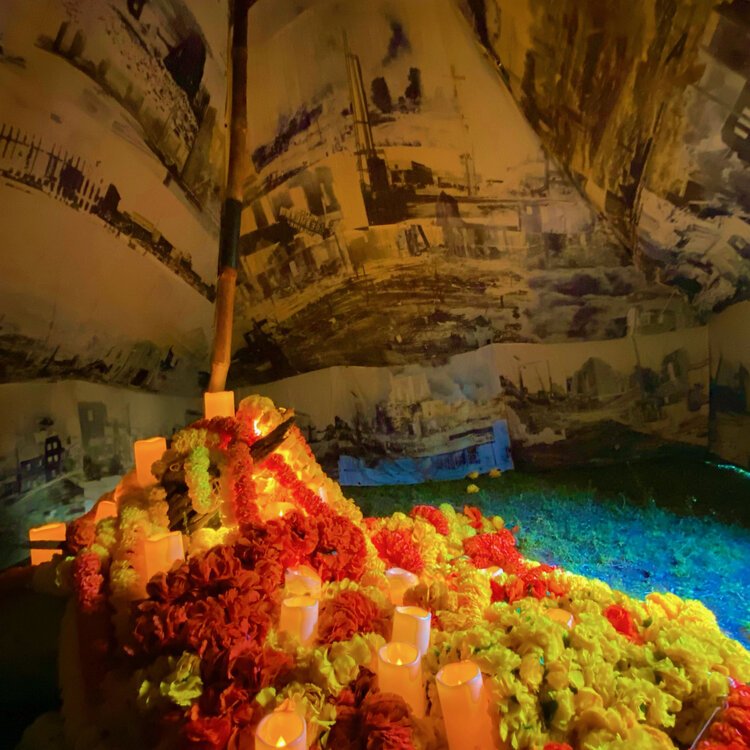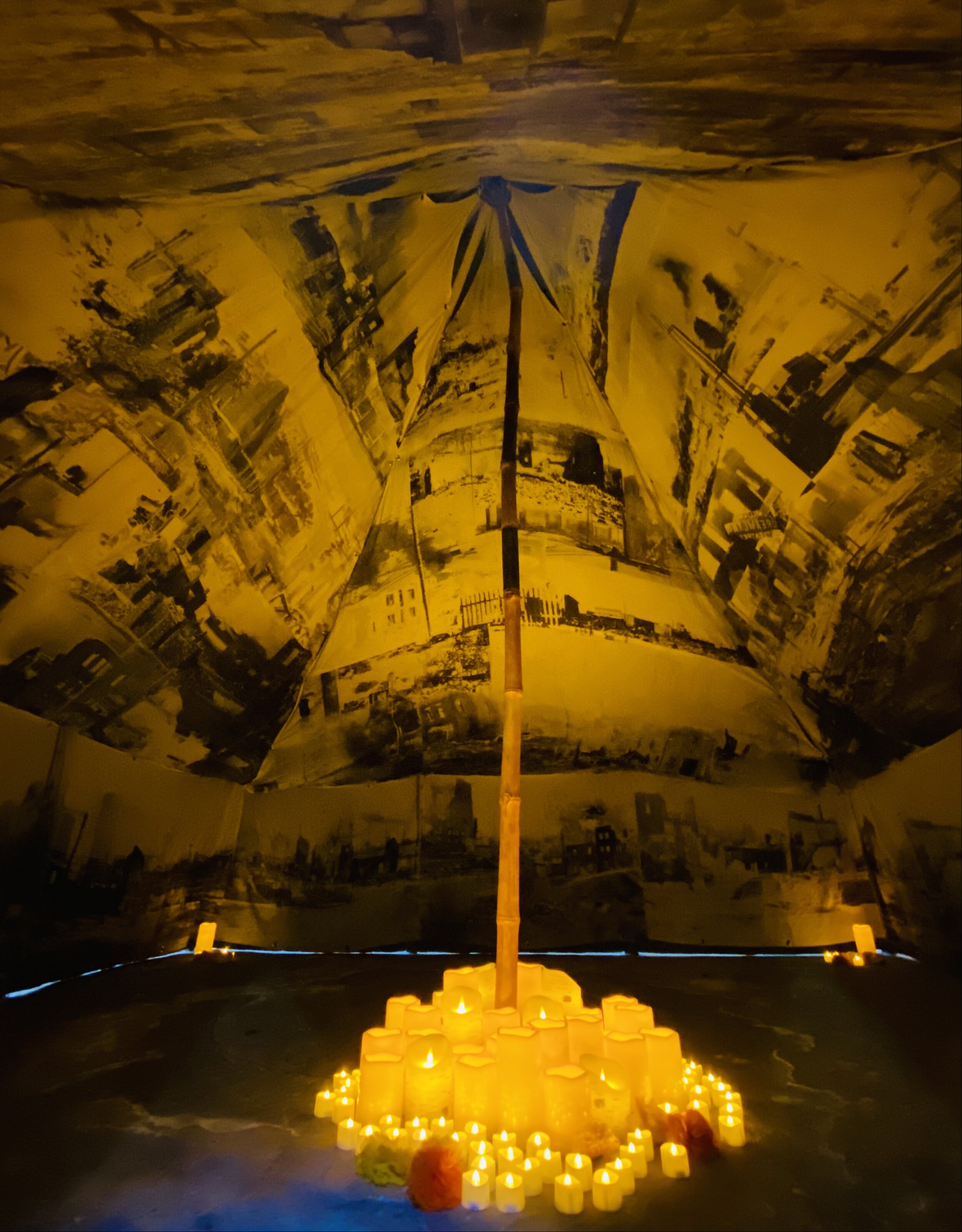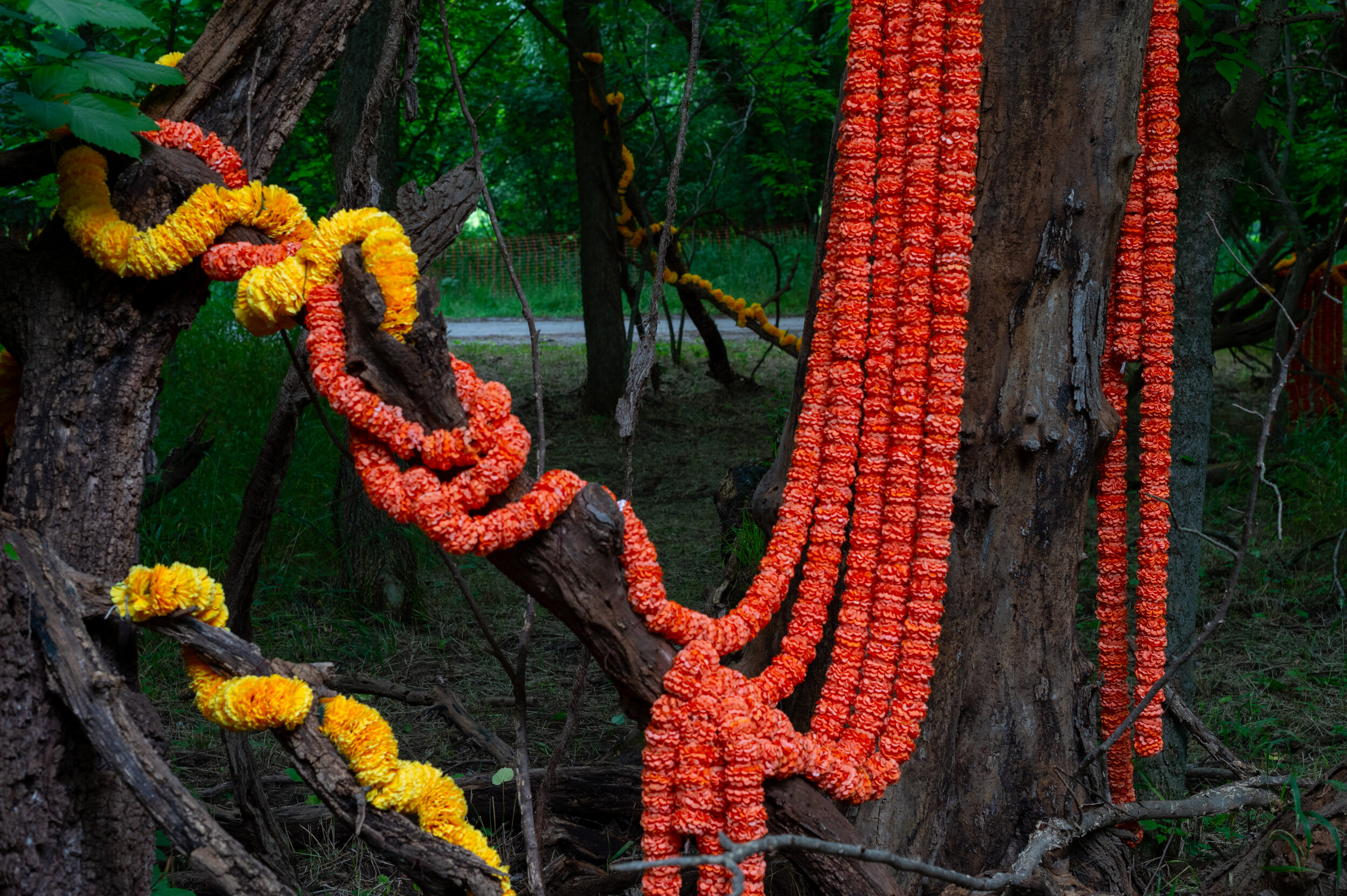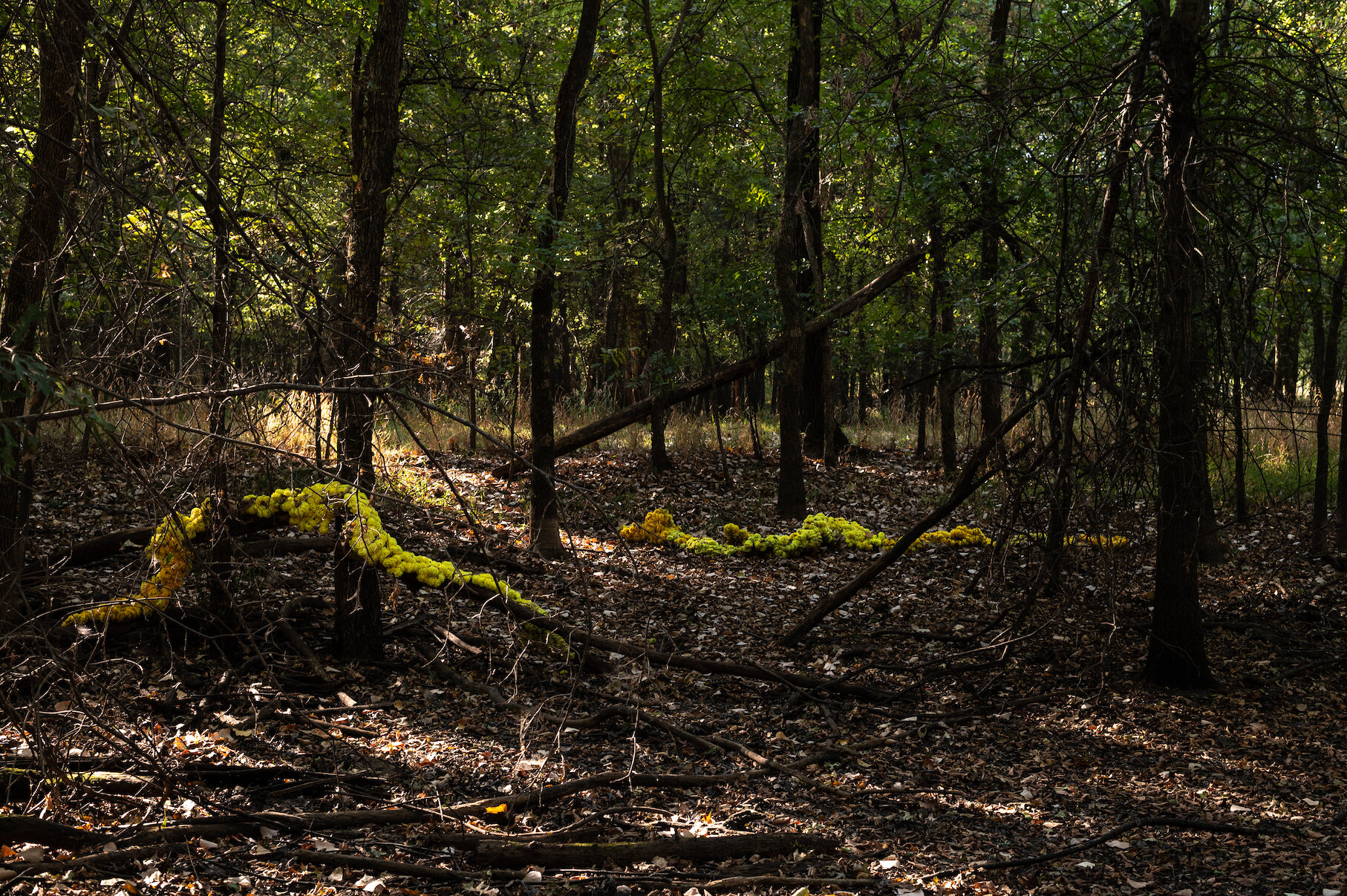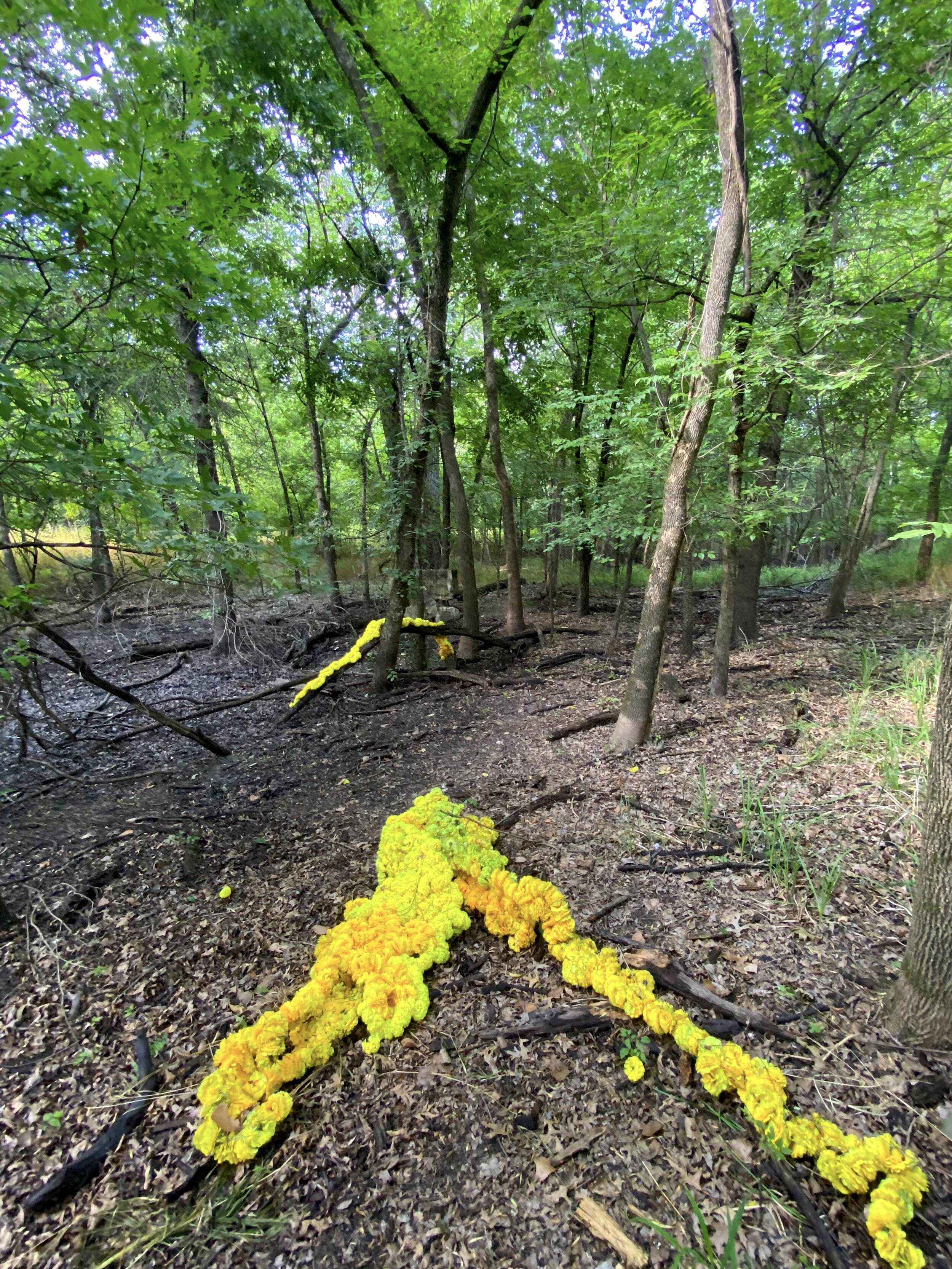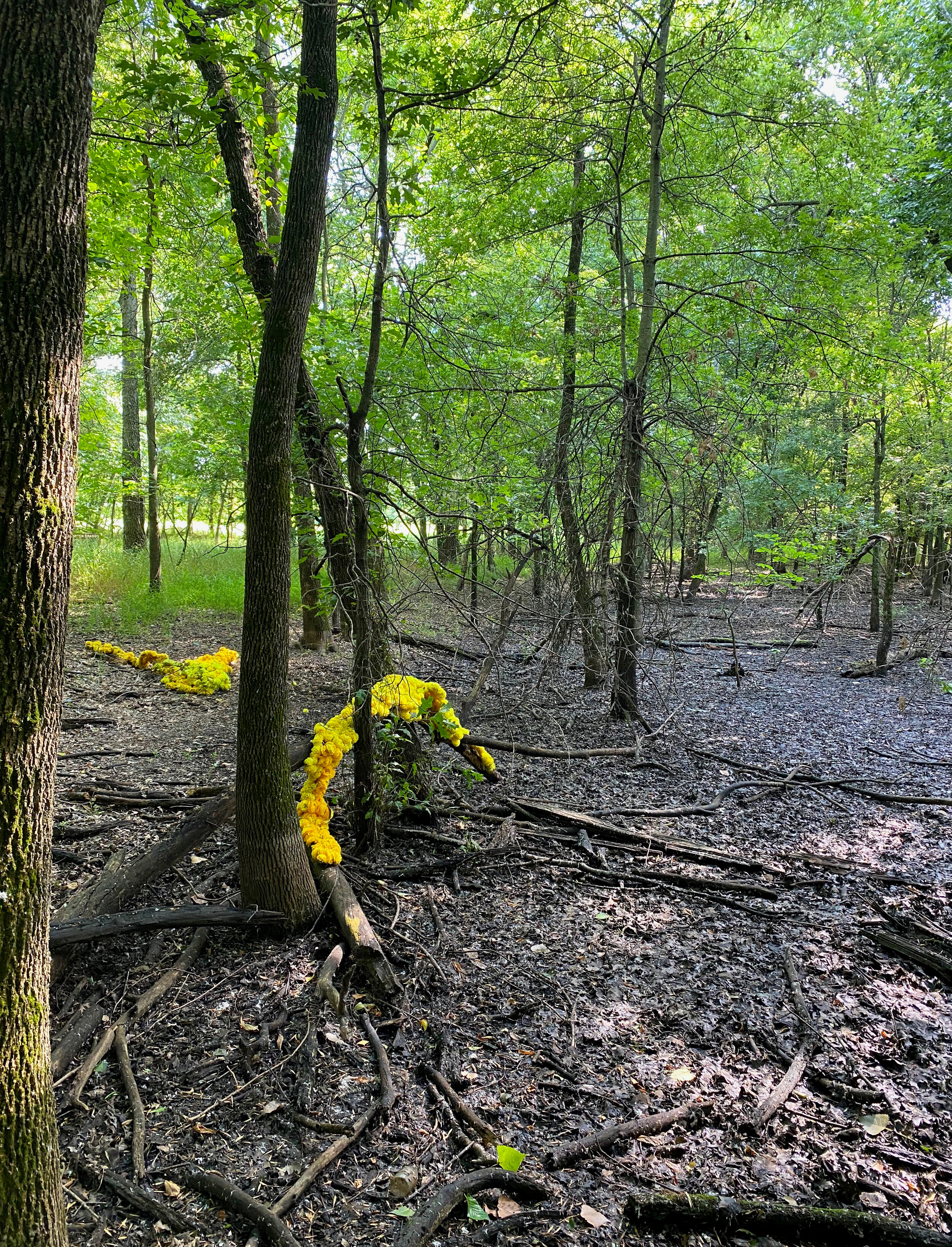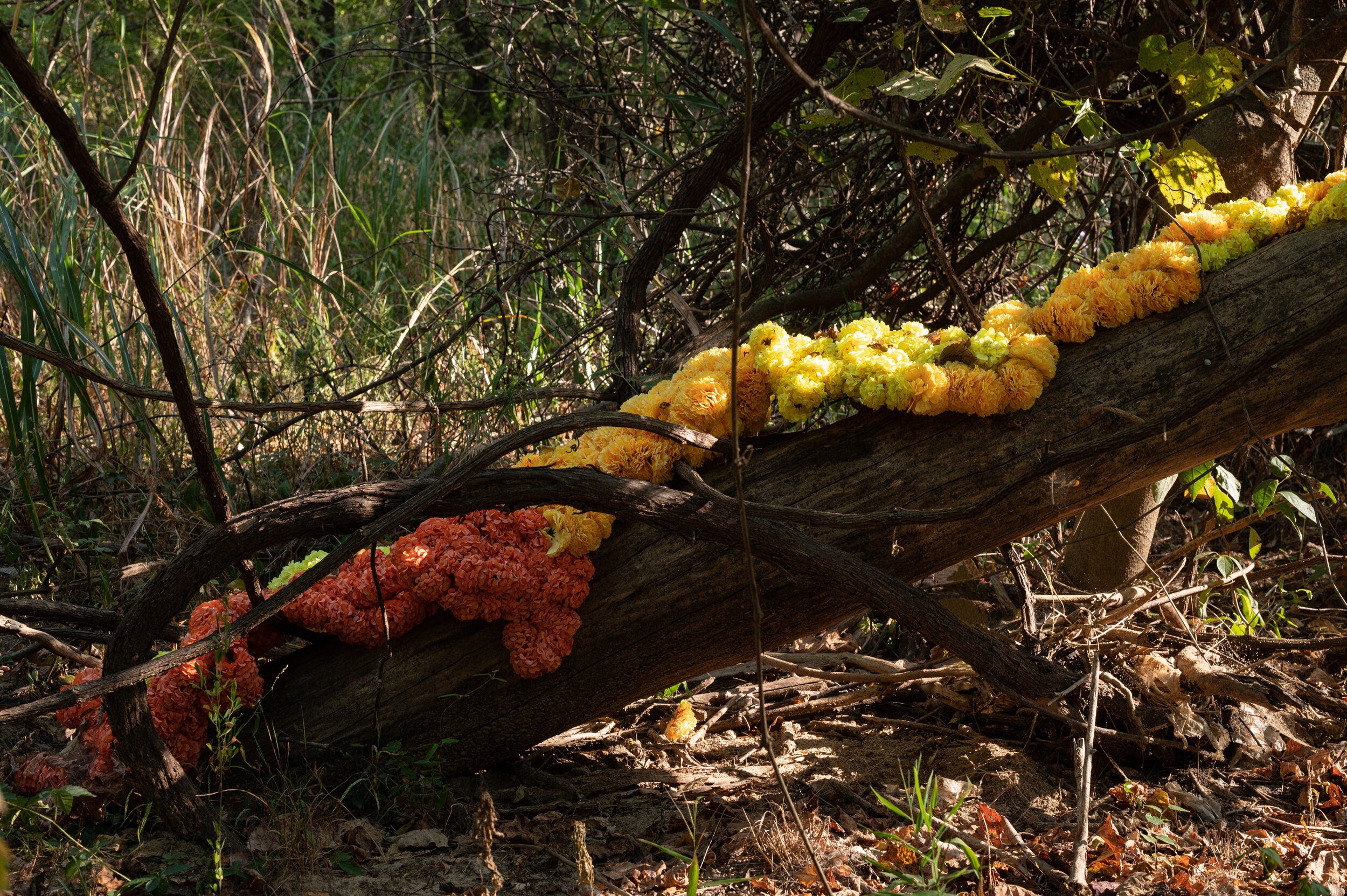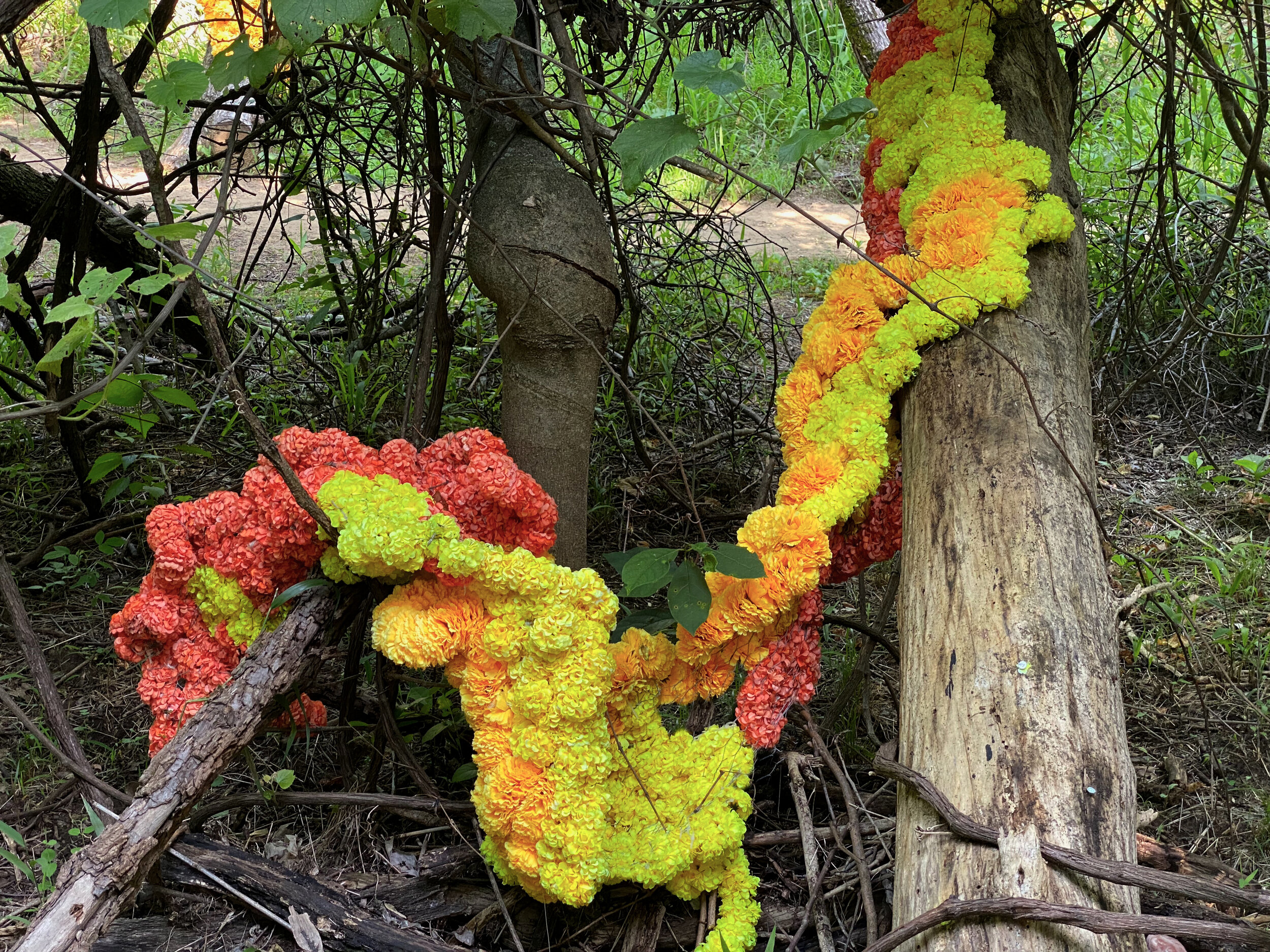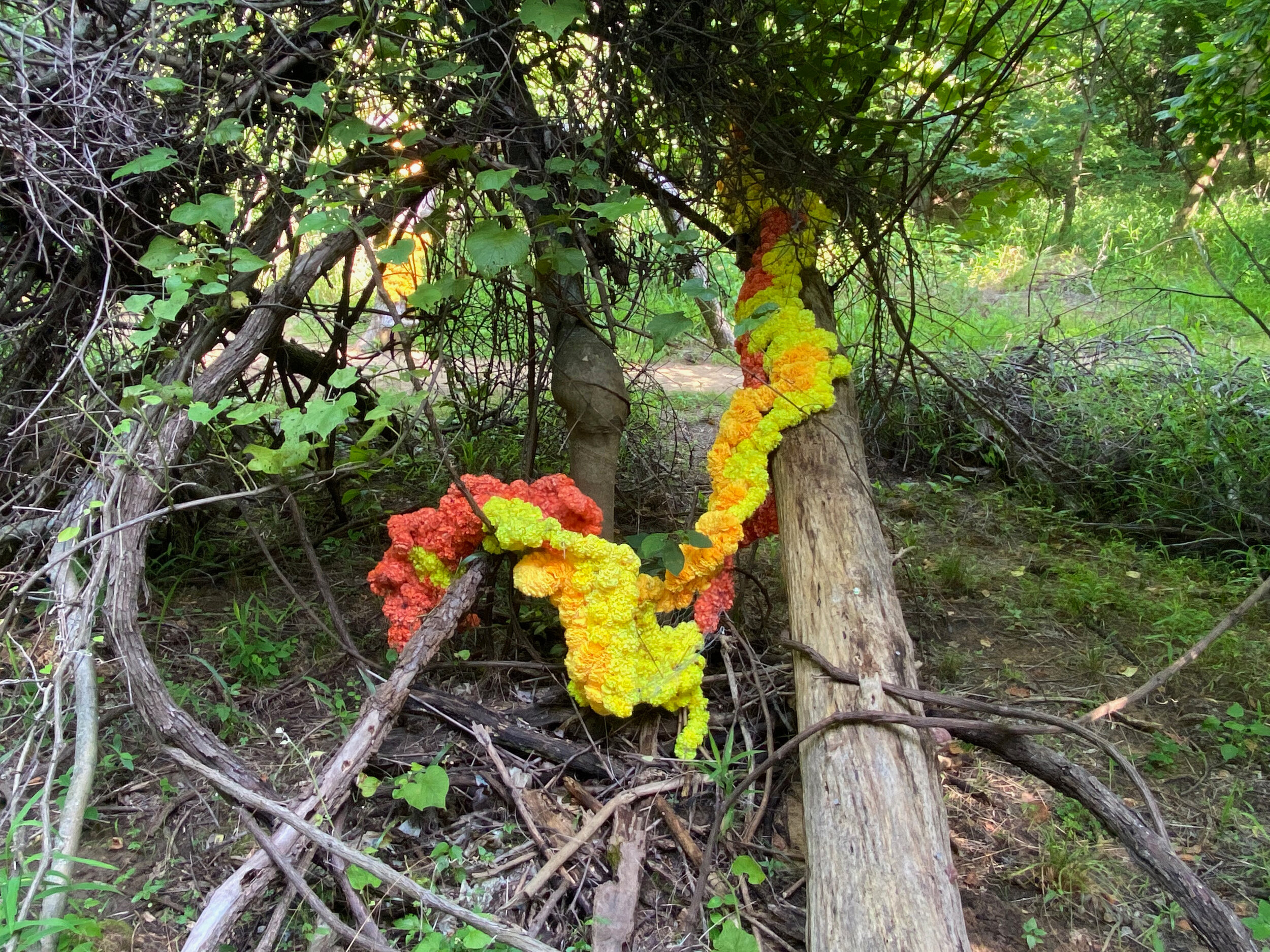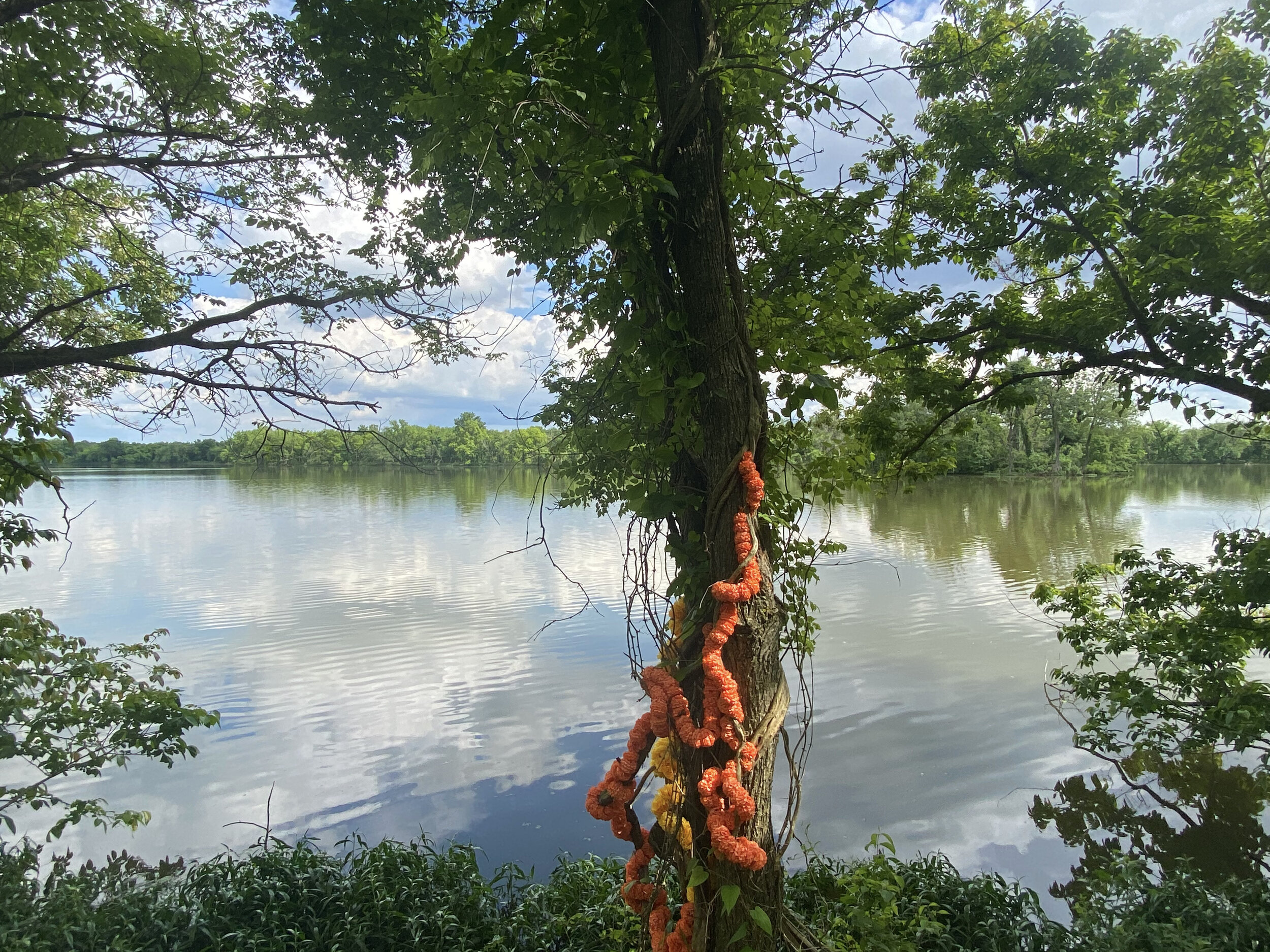The American Dream
2021
The American Dream (installation video, tent interior, tent); hand-crafted fabric flowers, printed fabric & canvas tent
Photocredits: Marlon Hall, Melissa Lukenbaugh, Sarah Ahmad
Greenwood Art Project
Sponsored by:
Tulsa Artist Fellowship
Bloomberg Philanthropies Public Art Challenge
Tulsa Race Massacre Centennial Commission, City of Tulsa
Oxley Nature Preserve, Tulsa, Oklahoma
The American Dream invites visitors to participate in transfiguring the loss and destruction of 1921 into a flowering memorial.
It is centered around a reconstructed refugee tent such as the ones used by families rendered homeless during the Tulsa Race Massacre of 1921. Marigold flowers adorn the tent and reach across the nature preserve at five additional locations, transforming the forest into a living tribute to the loss and resilience of Greenwood’s residents. While the blossoms visually recall the fiery explosions of bombs that destroyed people’s homes, here the marigolds also suggest renewal in the wake of tragedy. The American Dream offers a solemn memorial to the weight and tragedy of what was lost, as well as a message of hope, renewal, and solidarity.
“Community member D’Marria Monday provides an example of this in an email she recently sent describing her experience when viewing The American Dream, one of our installations created by Sarah Ahmad:
I stumbled along the path of the American Dream the other day. Nature centers me when I’m feeling lost and need to look within to find my way. I wandered along the path, still uncertain if I was going the right direction, not knowing what would lie ahead. Then, the beautiful radiance of the marigold flowers would renew my hope that I was going the right way.
Finally, I arrived at the teaching hut. A handmade woven tent with the pictures of devastation on the pattern inside. I ventured inside in the heat of the day. It was almost as if I could feel the fire as I was enveloped in the heat. I left feeling inspired by the fire of my ancestors’ blood pumping through my body. It was in this moment that I walked out with a renewed hope of resilience as I ventured along a new path. A hope that we can rebuild from the flames. Our ancestors experienced loss and devastation; just like the Phoenix, they rose from the flames. Our ancestors’ spirit of resiliency lies within.
As I continued the journey back, still lost at times, I was unsure if I would make it back okay. It was during these times that I was able to look within and feel inspired by the ancestors as a guide that I would make it back okay. That served to renew my purpose, direction and most of all HOPE. HOPE is Healing Our Post-Traumatic Experiences. I am thankful to the Greenwood Art Project for creating this experience in tribute to our ancestors. We’re able to look back and be inspired to move forward!”
Jerica D. Wortham, “Greenwood Art Project Director Jerica D. Wortham on Art’s Healing Powers,” ARTnews, December 22, 2021. https://www.artnews.com/art-news/artists/jerica-d-wortham-art-healing-powers-1234614059/
Excerpts from Amy Rosenblum Martin’s essay “Marigold Opacity” published in the Greenwood Art Project catalog “An Impulse to Keep”:
“Ahmad chooses not to indulge the imperative to produce overtly activist art. Instead, her project focuses on personal wellness through liberatory frameworks by cultivating ecotherapeutic practices with survivors of atrocities. In doing so, the artist stages her own rebellion within the ongoing rebellion for equity being fought within the US art world. It’s a continuous contest and recombining of tactics—ranging from overt to covert, from iconography to activist uses of art—all working toward justice.” ”
“By expanding the power of forest bathing as self-care into communal healing of communities at risk, Ahmad’s thinking resonates with Audre Lorde’s assertion: “Caring for myself is not self-indulgence, it is self-preservation, and that is an act of political warfare.””
“While Ahmad’s work in general is known for its light and transparency in experiential terms—for example, viewers shine flashlights as they walk through her colorful, lacy, geometric installations in darkened spaces—she instrumentalizes opacity at the conceptual level. Her efforts bring to mind conditions Édouard Glissant theorizes in which colonizers viewed the colonized as “Others” and demanded transparency in order to be able to categorize and rule them. In claiming the "right to opacity," he asserts that oppressed people should be permitted to be opaque, not fully understood, and simply to exist as different. Raised in a postcolonial context, Ahmad uses abstraction—one of her conceptually opaque art approaches—to hint at the universality of oppression and to protect her personal mindspace. For her, artistic opacity defies prevailing notions that activist art must make obvious political statements. She deliberately challenges US assumptions about what a politicized and racialized Pakistani woman artist “should” produce. She insistently exercises her freedom of self-determination, asserting it as a basic human right.”
The American Dream Tent
Photocredits: Sarah Ahmad & Marlon Hall
The TENT replicates those used by the African Americans made homeless by the Tulsa Race Massacre, and also stands as a larger symbol of state-sponsored violence around the world. The vivid imagery of the tent’s interior contrasts sharply with its plain exterior, reflecting the invisible nature of embodied trauma as it is passed on through generations. Yet too, the light within suggests a sense of hope and healing that can only be found through acknowledgement and honor.
Photocredits: Marlon Hall
May/June 2021
May/June 2021 & Feb. 2021
October 2021 documenting how the work changed over time in the forest over 5 months.
Fallen Giant Installation
Photocredits: Sarah Ahmad & Melissa Lukenbaugh
Update: This installation was vandalized between 6/4/21 and 6/12/21
Images of the installation documented on 6/12/21 after the vandalism.
REFLECTIONS ON VANDALISM
Garlands of flowers ripped and cut off, left in a scattered mess, the rubble of the destruction left behind, on which spiders and critters had already made their homes by the time I discovered it. This is the same spot at which a visitor to the site composed a beautiful poem.
Many visitors shared beautiful reflections, brought flowers to the memorial, one shared bags of marigold seeds she harvested over the years and brought them to share with visitors with the message that flowers “growing at their homes could be a reminder of the work humanity has to do to achieve unity and compassion for all.”
Another visitor shared scans of a book with a moving account of a survivor of the Tulsa Race Massacre who recounted how families sought refuge at this site in the Mohawk Park when they fled the massacre. These are some of the many community members I connected with through the work.
The many acts of generosity and beautiful reflections shared by visitors deserves mention in the conversations that the work has initiated.
May/June 2021
October 2021, documenting how the work changed over time in the forest over 5 months.
Clearing Installations
Photocredits: Melissa Lukenbaugh & Sarah Ahmad
Mock Installs for the Clearing
May/June 2021
October 2021, documenting how the work changed over time in the forest over 5 months.
Cornucopia Installation
Photocredits: Sarah Ahmad & Melissa Lukenbaugh
May/June 2021
October 2021, documenting how the work changed over time in the forest over 5 months.
Water Blooms Installation
Photocredits: Sarah Ahmad & Melissa Lukenbaugh
Update: This installation was vandalized between 6/4/21 and 6/12/21
Images of the installation documented on 6/12/21 after the vandalism.
The installation was uprooted from the ground, broken, and the larger pieces dragged and thrown under the tree with a small section left behind like a fractured limb left where it fell.
REFLECTIONS ON VANDALISM
The day I discovered the vandalism, I received an email from someone I didn’t know inquiring about visiting and sharing how she came across it on a post about Oklahoma Native Plants, “a lady was trying to figure out what was growing on the tree there is Oxley.”
Visitors to Oxley have been wondering what is growing on the trees. This was shared by the staff at Oxley Nature Center as well. Many installations have new habitats that have grown around them or under them. Some of the installations are now hidden under the wild grasses or vines already. Bees, butterflies, and dragonflies sit on the flowers either fooled by them since these are fabric flowers or drawn to them for the color. What nature has already claimed, humans intervene to vandalize?
Images of installation documented on 6/21/21
The blackwater has dried up in the scorching heat and the works sits on the fallen log and crumbled up on the dry ground now; thick cobwebs grown on some parts have trapped dewdrops that glisten like crystals, the fabric becoming tattered on the edges from being dragged around on the ground when the work was dragged and deposited under a nearby tree.
May/June 2021
October 2021, documenting how the work changed over time in the forest over 5 months.
Vines Embrace Installation
Photocredits: Sarah Ahmad & Melissa Lukenbaugh
Update: This installation was vandalized between 6/4/21 and 6/12/21
Images of the installations documented on 6/12/21 after the vandalism.
Parts of the work were stolen while some parts ripped off the log and flung over on the vines.
REFLECTIONS ON VANDALISM
“Wortham says the park is where many fled to find safety and the flowers are memorials for those seeking refuge.”-Jerica Wortham, Program Director of the Greenwood Art Project via Fox23 New: Art Installation Vandalized
“She says the artist plans to keep the installation as is, vandalized and all, to show that healing needs to still be done. Signs will be placed along the trail letting visitors know it’s been damaged. But if they were to remove it, it’ll honor those who came to disrupt versus the resilience of the victims of the massacre.”
Images of the installations before vandalism: “TULSA — In the verdant forests of Mohawk Park's Oxley Nature Center, bursts of yellow, gold and red blossom along fallen limbs, rotting logs and tree stumps, gleaming in the dappled light of the tangled trees.” 'Art speaks': Greenwood Art Project unveils wide-ranging commemoration of Tulsa Race Massacre by Brandy McDonnell via Oklahoman
Images of the work documented on 6/21/21
I had cleaned up the flowers that were ripped off the work and lay scattered on the ground. The piece flung on the log and vines creates a new composition. Letting go of the creative control of the work as each piece was designed and its placement planned by me but the intervention makes it an “uninvited collaboration” to quote William Cordova.
May/June 2021
October 2021, documenting how the work changed over time in the forest over 5 months.
Lake Offerings Installations
Photocredits: Sarah Ahmad & Melissa Lukenbaugh
Photocredits: Marlon Hall & Sarah Ahmad
October 2021, documenting how the work changed over time in the forest over 5 months.
Marigolds in my studio.
MARIGOLDS
In The American Dream, the brilliant orange and yellow marigold flowers are reminiscent of the fireballs that fell from the sky in Tulsa. Yet they have been converted into floral memorials to commemorate the lives lost but also the resilience and spirit of the Greenwood community, its survivors, and their descendants.
The marigold carries rich iconography, as the flowers appear in sacred contexts around the world. Native to North America, marigolds were carried abroad by colonial merchants. A member of the sunflower family, the modern marigold originates in Mexico, where it is currently used in Day of the Dead celebrations. Its English name is said to come from the term, “Mary’s Gold” in reference to its use as Christian offering, presented at altars in lieu of gold coins. Today the marigold is especially common in South Asia where they are made into garlands to festoon important occasions, used as offerings in sacred contexts, and honoring the dead - harking to their association with resurrection. Marigolds symbolize positive energy, renewal, and the warmth of the sun in modern western culture.
Images of marigolds paired with photos of firebombs taken from the internet.
Panel 1 for the tent, 36” x 148”
Image details used in the artwork are courtesy of Tulsa Historical Society & Museum.
Panel 2 for the tent, 36” x 148”
Image details used in the artwork are courtesy of Tulsa Historical Society & Museum.
Panel 3 for the tent, 36” x 148”
Image details used in the artwork are courtesy of Tulsa Historical Society & Museum.
Panel 4 for the tent, 36” x 148”
Image details used in the artwork are courtesy of Tulsa Historical Society & Museum.
Panels for the tent canopy, 112” x 148”
Image details used in the artwork are courtesy of Tulsa Historical Society & Museum.
Panels for the tent canopy, 112” x 148”
Image details used in the artwork are courtesy of Tulsa Historical Society & Museum.
Panels for the tent canopy, 112” x 148”
Image details used in the artwork are courtesy of Tulsa Historical Society & Museum.
Panels for the tent canopy, 112” x 148”
Image details used in the artwork are courtesy of Tulsa Historical Society & Museum.
The American Dream suggests parallels between the government-sponsored destruction of Greenwood and state-sponsored violence around the world. The exterior of the refugee tent evokes tragedy and displacement, connecting the local, historical assault on a vibrant community with brutality enacted on black and brown bodies on a global scale. The interior of the tent is filled with archival photos from the Tulsa Historical Society & Museum, showing Greenwood left in shambles. The images of Tulsa after the race massacre appear indistinguishable to those of Pakistan, in the wake of American drone strikes that killed hundreds of civilians and children and military strikes that kill civilians every year. Veiled from the outside world, the haunting scenes serve as a reminder of how intergenerational trauma is passed down through continued forms of oppression, forms that shape and affects our bodies, souls, and DNA.
TITLE
The title American Dream refers to the myth of equal opportunity for Black, brown, Indigenous, and communities of color. At the same time, the title serves as a testament to the fortitude of the Greenwood community, which achieved wealth and prosperity despite racial inequality, achieved their American Dream that was destroyed when Greenwood was burnt to ground but the survivors rose to rebuild it following the Massacre. The installation invites community members to redefine the “American Dream” on their own terms. It is meant to cultivate the process of envisioning new futures.
MARIGOLDS
The marigolds that animate the installation visually recall the fire-bombs that fell from the sky, burning down the wealthiest Black neighborhood in America. Yet here they also suggest transformation, bringing the vibrancy of the sun and the rich iconography of the blossoms themselves.
OXLEY NATURE CENTER
The forest setting is integral to The American Dream, asking visitors to leave the urban space and connect with the woods. In the forest, vegetation continually grows as fallen trees decay. The American Dream calls on the sense of peace and stability of these natural forms to equally honor past destruction, and invite healing through connection to the earth and its universal cycles of regeneration. At Oxley, the immersive sights, sounds, and smells of the forest create an embodied, sensorial experience of “forest bathing” that facilitates renewal.
INVITATION FOR PUBLIC ENGAGEMENT
Visitors are invited to bring flowers to the tent in offering. The American Dream seeks to foster a healing process for the victims of the Tulsa Race Massacre and of massacres in all parts of the world.
PROCESS / MINI DOCUMENTARY ON GOOGLE ARTS & CULTURE
Some of the work process was recorded in the Greenwood Art Project’s Mini Documentaries on Google Arts and Culture. Shot at Oxley and the studio contributed by Michael Sager for the project, the documentary captures some of the behind-the-scene work process.
American Dream: A Visual Poem with Sarah Ahmad
https://artsandculture.google.com/asset/american-dream-a-visual-poem-with-sarah-ahmad-marlon-hall/xQH88Rd-waliKw
GREENWOOD ART PROJECT
The American Dream is my contribution to the Greenwood Art Project that is an initiative of the 1921 Tulsa Massacre Centennial Commission funded broadly by the Bloomberg Philanthropies through the Public Art Challenge. The Greenwood Art Project is overseen by nationally recognized lead artists Rick Lowe and William Cordova, with Tulsa luminary Jerica D. Wortham as program director. Tulsa’s Greenwood Art Project has gained national attention—from mention in Forbes and the New York Times, to placing Tulsa on both Conde Nast’s and National Geographic’s best travel destinations in 2021.
The essay "Marigold Opacity" by curator Amy Rosenblum-Martín about the project The American Dream is publihsed in the Greenwood Art Project catalog “An Impulse to Keep.”
Amy Rosenblum Martín is a New York-based independent curator of contemporary art for museums. This bilingual (English/Spanish) curator has long been a leader in the field of Latinx art, committed to equity and community engagement. Formerly a staff curator at the Pérez Art Museum Miami (when it was MAM) and The Bronx Museum, she has also worked for MoMA, MoMA PS1, The Met, the Guggenheim (Education), MCA Chicago, The Hirshhorn, MACBA (Barcelona), Reina Sofía (Madrid), London's National Portrait Gallery and Kunsthaus Bregenz (Austria) as well as MIT, NYU, The New School, Peking University and Colección Patricia Phelps de Cisneros.
MEDIA & NEWS
*ARTnews
Bomb Magazine
*Southwest Contemporary
Google Arts & Culture, Ethnographic Documentaries, A Visual Poem for Sarah Ahmad
Google Arts and Culture, American Dream (Mini-documentary by Marlon Hall)
PBS News Hour
Gallery America PBS Season 7, Episode 1 Sarah Ahmad, July 2021 “OETA’s Emmy Award winning Gallery America brings you the best in the arts from Oklahoma and around the nation. Hosted by Robert Reid”
Harlem World
Gallery America: Sarah Ahmad, Preview on Youtube
Gallery America Preview: Sarah Ahmad's "American Dream"
Final Friday with Gallery America, June 2021
Odyssey (magazine cover image posted on Twitter by OETA)
*The Oklahoman
The Oklahoman
Artnet News
Tulsa World
Root Tulsa
USA Today
KGOU NPR Partner Station
Name Publications: An Impulse to Keep
DailyAdvent
ARTnews
yogisden blog
allarts.org
seacoastonline.com
tulsapeople.com
The Oklahoma News Report on Vandalism
Fox23 Report on Vandalism
PROJECT SPONSORS
Tulsa Artist Fellowship
Bloomberg Philanthropies & George Kaiser Family Foundation
Oklahoma Visual Arts Coalition
Karvaan Crafts Foundation that is dedicated to helping women in rural areas of Pakistan through training in “skills and market knowledge to sell their products in urban markets.”
Zonia Anwaar Design House, Lahore, Pakistan
Laila Nusrat, Bali Memorial Trust, Pakistan
Kaytea Petro, Gnome Island Studios, San Francisco, CA
Lews Auto Trim, Tulsa, OK
Third Floor Design, University of Tulsa, School of Art, Design, and Art History
Chris Lilly, Lilly Architects, Tulsa, OK
Tulsa Historical Society & Museum
Teresa Valero
Michael Sager
Monica Basu
Hasnain Aslam
Hajra Khan
Susan Baley
Romy Owens
Carmen Schumacher
Sheila Givens,
Seema Abbasi
Maryam Ahmad
Jaya Richardson
Saberah Malik
L Joi McCondichie
Afiniti
Ibex Global
Salima Hashmi
Image details of the Tulsa Race Massacre used in the artwork are courtesy of Tulsa Historical Society & Museum.
© 2014-2024 Sarah Ahmad. No content on this site may be used without permission. All Rights Reserved.






